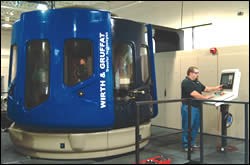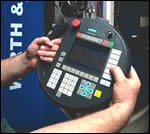Transfer Machines Help Regain Business In The States
As companies continue to wrestle with offshore competitors, many are finding that the use of transfer machines aids the situation. Once used solely for dedicated machining of high-volume parts runs, transfer machines now give OEMs and job shops enhanced flexibility because of the improved onboard controls. Medium-quantity runs, as well as smaller batches of complex parts, are now suitable for properly equipped CNC transfer machines.
As companies continue to wrestle with offshore competitors, many are finding that the use of transfer machines aids the situation. Once used solely for dedicated machining of high-volume parts runs, transfer machines now give OEMs and job shops enhanced flexibility because of the improved onboard controls. Medium-quantity runs, as well as smaller batches of complex parts, are now suitable for properly equipped CNC transfer machines.
TPS International, Inc. (Sussex, Wisconsin) finds many customers receptive to this notion. The company, established in 1981, sells, services and develops applications for a variety of European- and American-built machine tools, as well as its own line of positive contact broken tool sensors. TPS customers are OEMs and job shops in automotive, appliance, valve, fitting and other industries. With sales and service offices throughout the United States and also in Switzerland, the company maintains close contact with its customers and builders.
In one application, a TPS customer, Magnus Precision (Phelps, New York), produces a complex steel firearm component in 22 seconds on a Wirth & Gruffat Transturn TT 312 rotary transfer machine. On this machine, the capabilities of a multi-spindle screw machine are combined with a CNC rotary transfer machine to achieve as much as 60 axes of movement, which substantially reduces the overall production time on complex parts. The system completes the part from barstock, with operations including multi-side turning, reaming, milling, tapping and slotting. The Transturn replaced seven machine tools and the associated labor and operating costs.
A key to the transfer machine’s ability to multitask in this manner is the Siemens Sinumerik 840D CNC with four numerical control units and the Siemens Simodrive 611D with a numeric converter for 60-axis control and independent sequencing of all workpiece action.
The Transturn features 12 stations, including a load/unload station equipped to automatically feed a cutoff blank that is supplied by a connected sawing and elevating system. The remaining 11 stations can be equipped with two-axis CNC upper and lower cross slides mounted to cast iron columns. Each cross slide can accommodate static or driven tools allowing more than 22 horizontal, vertical or angular machining operations to be completed in a 12-station envelope. One station is generally used to invert the part within the machining sequence. Each workpiece clamping collet or chuck is an independent C axis and can rotate as much as 6,000 rpm. The CNC controls each of the 12 C-axis spindles, including all the upper and lower X- and Y-station axes. The index table is also driven by a CNC.
Hank Kohl, vice president and manager, TPS Machine Tool Solutions Group, explains the transfer machine trend. “Some of the developmental work we do with our U.S. customers becomes the platform for design for the machine builders. Often, our approach of designing unique solutions to unique manufacturing challenges opens up new ways of thinking for our machine builders. A customer can justify using a transfer machine if the productivity comes with CNC flexibility.” Mr. Kohl continues, “The Transturn was the fusion of these ideas. In real time, all functions needed to be programmable, and the basic PLC wouldn’t get us there. We essentially furthered an evolutionary process for a PC-based control and drive package by working with Siemens. Its digital drives could run in close proximity without excessive noise and with real-time feedback.” TPS also supplies its own software packages with transfer machines based on customer and application requirements.
“Overall, the Siemens platform enabled this machine to be built,” Mr. Kohl adds. “Because of outsourcing, more job shops are looking for the complex parts and unique capability transfer machines such as the Transturn, to remain competitive. Targeting complex part manufacturing with fast cycle times, quick change-overs and a high degree of automation has resulted in North American firms recapturing business lost to China and creating new business opportunities for themselves. This is not limited to automotive suppliers. Our customer base includes both OEMs and job shops in the appliance, fluid power, plumbing, power tool, small engine, ordnance and medical industries,” Mr. Kohl explains.
Additional benefits cited for the transfer machine include a smaller machine footprint, less inventory, the ability to machine the part complete in one cycle and an enhanced “lights out” potential for the customers.
With the help of transfer machines like the one TPS uses in its shop, which includes controls allowing the ability to multitask, more metalworking will be completed in the United States, keeping domestic manufacturing strong.
Related Content
CNC Rotary Transfer Machine Features Ballscrew Electromechanical Tooling Units
A CNC rotary transfer machine, a newly developed machine platform, is said to offer high rigidity, flexibility and accuracy for a range of high-volume, precision-machining applications.
Read MoreEdge Technologies Bar Feeder Maximizes RPM Potential
The second-generation Patriot 338 and 551 were designed for faster changeovers, ease of use and safe operation.
Read MoreIndependent Turning Cell Enables High Concentricity Precision
PMTS 2023: The RV 10 Flexmaster rotary transfer machine’s precision turning cell (PTC) is integrated in the machine as a disconnected turning cell and is free of the drive and machining factors that affect the other stations.
Read MoreRotary Transfer Technology Becoming More Flexible
This rotary transfer machine platform, which enables shops to reconfigure equipment to change over to new jobs as needed, is said to be effective for batch sizes of only 50 parts.
Read MoreRead Next
Rotary Transfer Machines For Extruded Bar
To address the requirements of extruded bar applications, Italian builder Picchi, which is distributed in the United States through RBR Associates (Darien, Illinois), has developed a line of rotary transfer machines designed to handle round, hex, square, rectangular, elliptical and even complicated extruded shapes.
Read MoreComplete In One Chucking
Compared to barstock, castings, forgings and sawn blanks present a different set of workhandling challenges for production machining. This article looks at how Hydromat Inc. is meeting these challenges on its rotary transfer machines with engineered indexing workholders.
Read MoreDo You Have Single Points of Failure?
Plans need to be in place before a catastrophic event occurs.
Read More

.jpg;maxWidth=150;quality=70)




















.jpg;maxWidth=400;quality=70)


